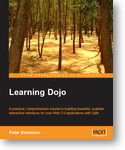I just finished reading the Learning Dojo book, authored by Peter Svensson and published by Packt Publishing . They sent me a free review copy of the book and this is a personal and independent review of the book.
For starters, Dojo is a powerful Ajax framework with a wide variety of functionality. There are a lot of Javascript libraries out there like jQuery, YUI, Ext etc and it is clearly a matter of choice and requirements at hand which library you end up using. However, Dojo claims to be the most feature packed AJAX framework around.
The book was a pretty smooth read and at no point I felt like going out of the flow or jumping across without covering anything. The book is targeted at web developers who have some basic knowledge of Javascript/HTML/CSS and would like to learn more about the Dojo framework. The book quickly gives an introduction of what Dojo is all about and its capabilities and then starts to explain more in depth details with side by side examples. There are examples everywhere in the book (code samples) and at some places, the core library files are also discussed to explain how Dojo is handling things behind the scenes. After the introduction chapter, the book discusses things like Dijits (Dojo’s name for widgets), Forms, Layouts all with relevant code samples where required. I was impressed with Dijits in particular. Its pretty easy to load any Dijits (widgets) and there seem to be quite a large number of Dijits built in already for just about everything (forms, extended form elements, color pickers etc) and you can write your own as well, obviously. I also liked Chapter 7 in particular as it speaks about dojox.data package which has some really useful Stores under it, like eg. you can use the FlickStore to read Flickr feeds and PicasaStore to read Picasa web albums. I think this is the most interesting part of the framework, although the stores under dojox.data are still in an experimental state.
Overall, I think the book is a pretty decent book and gives you a good head start in getting yourself acquainted with the Dojo framework. At some places, the author explains basic Javascript concepts as well, in order to explain Dojo’s way of handling things, which I think is a good thing as it looks like there has been a good effort here. One particular thing that I kinda overlooked earlier but realized after reading the book, is, the power of console.dir() in the debug console window. As I said, this is not something related to Dojo in particular, but since the author makes an effort to explain things from the root up, this little tip was a good find for me.
The only minor criticism I have is, I spotted some minor English mistakes in a couple of places and at one place in Chapter 3, the sample code was unrelated to the discussion at hand. I know its not a big deal and I am being fussy, but, I think this needs to go in as part of the review. Also, I would have liked to read a little bit on how Dojo is or is not affected if used in conjunction, on the same page, with other libraries like jQuery or Prototype.
The Dojo framework is available via the Google CDN and AOL CDN as well, which means you don’t really need to download the framework and be bothered with distributing it with your application, as you can simply use them from either of the 2 sources. By doing this, you dont even need to worry about updating the versions of the API as you just load the required version from the CDN.
There is one chapter of the book available online as well. Chapter 6 on Layouts is available here if you want to get a feel of the reading. Also, you can download the sample code that comes with the book from here. Apart from that, Dojo samples/demos can be found here as well.
Finally, I would not hesitate in recommending this book to anyone who wants to get a understanding of Dojo and start using the toolkit. The book touches down on everything to give you the understanding on the capabilities and flexibilities of the framework. I think that’s fair as the book clearly does what it says “Learning Dojo“. It teaches you Dojo but you got to enhance your skills on your own.
Following is a list of Dojo related resources :-
The Dojo framework
The Online Dojo Book
Dojo Training and Tutorials
Dojo API Docs





This is the link you have for the Google CDN right now : http://getfirebug.com/console.html
@Allen,
Thanks for pointing that out. The link is now fixed. Cheers.
Free Dojo Toolkit eBook:
http://www.heronote.com/files/Dojo.htm